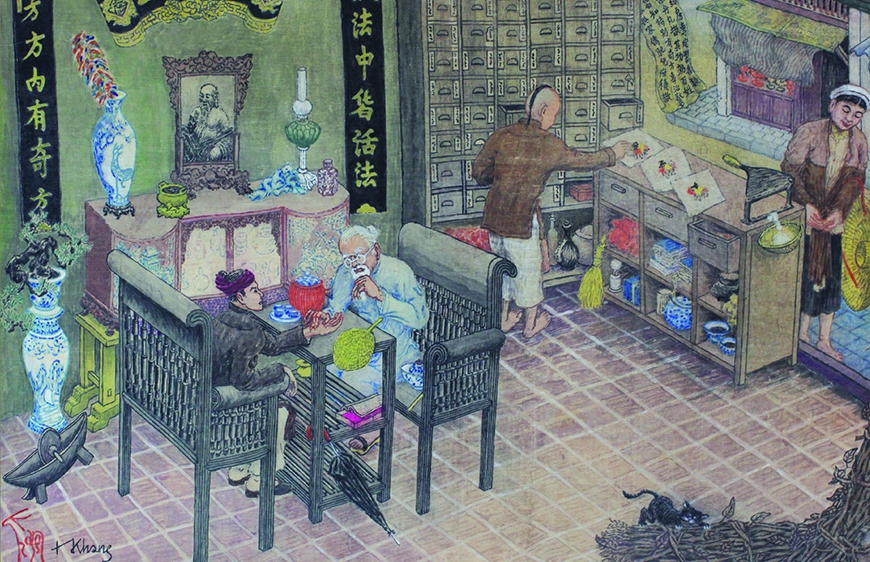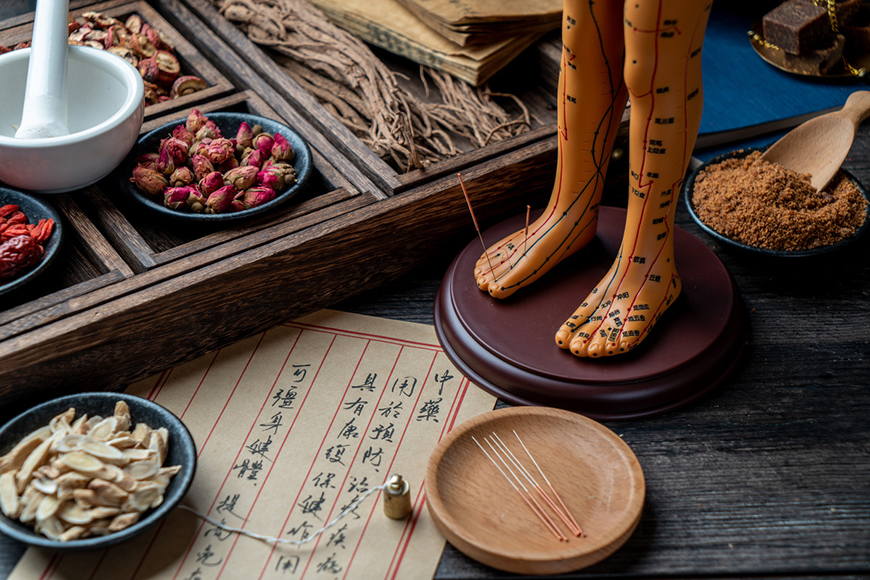In the heart of Vietnam, nestled between age-old traditions and growing modernity, lies a timeless medicine with hidden virtues: Traditional Vietnamese Medicine. Far from being a simple alternative practice, it is a veritable way of life, a holistic philosophy that aims to preserve the vital balance of body and mind.
An ancestral heritage
Drawing its roots from the depths of Taoist and Confucian thought, traditional Vietnamese medicine, also known as "Thuốc Nam" (literally "Southern Herbalism"), draws much inspiration from its Chinese neighbor, while distinguishing itself through diagnostic techniques and a preference for local medicinal plants. Over time, and influenced by Indian and local traditions, this practice has evolved, adapting to the needs and beliefs of the Vietnamese people.

Traditional Apothecary - Illustration: Internet
Beyond symptoms, a holistic vision
Unlike Western medicine, which often focuses on treating symptoms, traditional Vietnamese medicine takes a holistic view of the individual. It sees the human being as an inseparable combination of body, mind and environment.
Health is not solely linked to illness, but rather to an overall imbalance in your vital energy, called "Qi". The aim is to restore this vital balance, the source of health and well-being. So it's all a question of balance, just as the balance of Yin and Yang between two opposite states (like cold and hot), according to the principles of Oriental medicine, is important in the human body. Yin is the feminine principle: the moon, darkness, coldness, receptivity and so on. Yang, on the other hand, represents the male principle: the sun, radiance, heat, action, etc. Another major theory is that of the five elements - water, wood, fire, earth and metal. Water represents the kidneys, wood the liver, fire the heart, earth the stomach and metal the lungs. The harmony of the five elements (five organs) and Yin-Yang are thought to contribute to the harmonious development of our body.
A natural, ancestral pharmacopoeia
To restore lost harmony, Traditional Vietnamese Medicine offers a wide and varied range of therapies. Medicinal plants, acupuncture, massages and dietary recommendations are all part of a personalized program tailored to each individual's specific needs. Vietnam's luxuriant and generous nature offers an infinite range of remedies for TMV. Leaves, roots, flowers, fruits... Each plant possesses unique properties, carefully selected and combined to create personalized remedies. Commonly used plants and herbs include Vietnamese ginseng, turmeric, ginger, cinnamon, lotus flower and water hyacinth. Anecdotally, it's still common today to chew betel to prevent tooth decay and consume ginger to protect against sore throats and the flu. Similarly, a bowl of sweet lotus seed soup is sworn by to treat sleep disorders.
A sensory and beneficial journey
In addition to medicinal plants, traditional Vietnamese medicine offers a full range of therapies: acupuncture, moxibustion, Tui Na massage, Qi Gong-inspired breathing exercises and dietary recommendations.

Basics of Oriental Medecine - Photo: Adobe-Stock
The most common practices of Traditional Vietnamese Medicine
- ♦ Acupuncture: Acupuncture involves inserting fine needles into precise points on the body to stimulate energy channels and restore energy balance. Note that acupressure (bâm châm) achieves the same effect by applying finger pressure to acupuncture points.
- ♦ Moxibustion: Moxibustion uses dried mugwort (Artemisia vulgaris) to heat acupuncture points and promote energy circulation.
- ♦ Traditional Vietnamese massage (Tẩm quất): Traditional Vietnamese massage is a therapeutic technique that uses pressure, stretching and rhythmic movements to relieve muscle tension, stimulate blood circulation and balance energy. It focuses on muscles and tendons, targeting specific pressure points to release tension and promote relaxation.
- ♦ Herbal medicine: Phytotherapy uses Vietnamese medicinal herbs to treat a variety of ailments. Herbs are often prepared as decoctions, powders or infusions for per os consumption. It should be noted that the Red Dao, a minority ethnic group in Tonkin, are experts in the medicinal use of certain plants. Their herbal baths (composed of 10 to 120 different species!) are highly reputed.
- ♦ Dietetics: Playing an essential role in traditional Vietnamese medicine, dietetics recommends specific foods to balance yin and yang and promote general well-being.
- ♦ Energy practices: Practices such as tai chi, qi gong and Vietnamese yoga are used to harmonize vital energy, strengthen the body and calm the mind.
- ♦ Cupping therapy (Giác Hơi): An ancient Chinese therapy involving the use of cups to create suction on the skin, stimulate blood and energy circulation, relieve muscle pain and eliminate toxins.
- ♦ Breathing techniques: Deep, conscious breathing is often encouraged to regulate energy and promote relaxation.
And then I'd also like to mention this practice that I leave to your judgment, Gua Sha or cạo gió, in Vietnamese. All the grandmothers here know it: to unblock meridians and promote the circulation of energy in the body, nothing is more effective than scratching the skin with a smooth-edged tool (often a coin), and this to cause a superficial bruise. This practice has been used for centuries to treat a wide range of ailments, including pain, inflammation, fatigue and muscular tension. Today, it is mainly used to treat colds and other chills....

Traditional Medecine Room - Photo: FITO Museum
Traditional Vietnamese Medicine: Today and tomorrow
Traditional Vietnamese Medicine continues to be practiced and appreciated in Vietnam today. It plays an important role in the Vietnamese healthcare system, complementing modern Western medicine.
In my opinion, here are a few perspectives on this ancient practice:
✓ Official recognition: Traditional Vietnamese Medicine is officially recognized and regulated by the Vietnamese government. There are training and research institutions dedicated to its development, and qualified practitioners are authorized to practice (I'm thinking in particular of the National Acupuncture Hospital in Hanoi).
✓ Mixing approaches: MTV is increasingly integrated with modern Western medicine. Vietnamese hospitals combine the two approaches to provide comprehensive healthcare and meet patients' needs.
✓ Promoting research: Scientific research into traditional Vietnamese medicine is expanding. Studies are being carried out to assess the effectiveness of certain practices and better understand their mechanisms of action.
✓ Medical tourism: Vietnam is attracting a growing number of international tourists interested in the wellness practices of traditional Vietnamese medicine. Travellers come for treatments, health retreats, or simply to explore this ancient medicine and its practices.
✓ Modern adaptation: Traditional Vietnamese medicine is also adapting to modern needs. Mobile applications and online platforms have been developed to facilitate access to information and consultations with practitioners.
While traditional Vietnamese medicine retains its overall popularity and importance in Vietnam, it is also seeking to meet the demands of modern society.

Traditional Pharmacopeia - Photo: Shutterstock
Did you know?
Traditional medicine street in Ha Noi
When visiting Hanoi, don't miss the street dedicated to traditional medicine in the old quarter of the 36 guilds, where you'll find herbal stores. The establishment of apothecaries in this district dates back to the early 19th century, during French colonization, when many Chinese families immigrating from China's Fujian province began to popularize their practices. Today, rue Lãn Ông (named after the nickname of Le Huu Trac, a well-known 18th-century Vietnamese doctor) reflects this history, where families continue to sell their remedies daily to locals, often consumed in the form of infusions or inhalations. Along with Rue Thuốc Bắc, it has retained irresistible scents, an important part of the capital's soul.
FITO Museum in HCM-city
Founded in 2007, the FITO Museum, also known as the Museum of Traditional Vietnamese Medicine, is a private institution and the first museum dedicated to traditional medicine. Its founder is Mr. LE Khac Tam, a passionate pharmacist. Over a period of more than 10 years, he has assembled a collection of over 3,000 objects, documents and utensils (some dating back to the Stone Age!) related to this traditional pharmacopoeia. A visit to this museum is an unusual, captivating and highly instructive experience.
Practical info :
Address: 41 Hoang Du Khuong, Ward 12, District 10
How to get there: By cab or Grab, 30 mins from downtown
Opening hours: daily from 08:30 to 17:00
Price: Adults 180,000 VND/Children 90,000 VND
A few tips to help you integrate the practice of Traditional Vietnamese Medicine into your daily life
A balanced diet
Adopt a balanced diet, giving priority to fresh, local and seasonal foods. Eat a variety of vegetables, aromatic herbs and spices such as turmeric, ginger and coriander. Limit consumption of processed foods and prioritize healthy cooking methods such as steaming or stir-frying.
Practice meditation and relaxation
Allow yourself a few moments of serenity and meditation each day. Deep breathing, sitting meditation or relaxation exercises such as tai chi or qi gong are all possible options.
Using herbs and natural remedies
Incorporate Vietnamese medicinal herbs into your daily life. For example, you can enjoy Vietnamese ginseng tea to boost energy and strengthen the immune system. Turmeric can be incorporated into dishes for its anti-inflammatory properties. However, it is essential to consult a qualified physician or herbalist for proper advice on the use of herbs.

FITO Museum - Photo: FITO Museum
Massage and relaxation techniques
Why not incorporate basic massage techniques into your daily routine, such as self-massage of the hands, feet or face? This can help relieve stress and encourage relaxation.
Physical exercise
Regular exercise is recommended by Traditional Vietnamese Medicine to maintain a healthy, balanced body. Explore a physical activity suited to your preferences, such as walking, jogging, yoga or dancing. Keeping active and moving regularly is essential to boosting your vitality and overall well-being.
A precious gift for your well-being
Traditional Vietnamese Medicine is more than just a temporary solution: it's a genuine investment in your long-term well-being. By embracing its principles and incorporating its methods into your daily life, you'll open up a new perspective on well-being, a source of lasting balance and harmony. The discovery of Traditional Vietnamese Medicine goes beyond simple medical practice. It allows you to enjoy a period of well-being, exploring a culture filled with ancestral traditions and wisdom. It involves becoming aware of the importance of listening to oneself, respecting nature and balancing body and mind.
Whether it's for chronic problems, to boost your immunity or simply to relax, Vietnamese medicine offers you all its possibilities. It invites you to a sensory and introspective exploration of harmony.
So don't wait any longer! Explore Traditional Vietnamese Medicine and experience a sensory journey that will revitalize your body and mind!